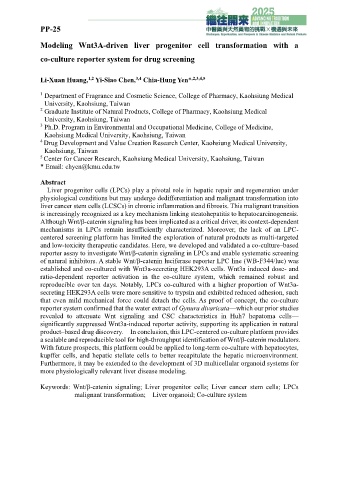Page 207 - 2025中醫藥與天然藥物聯合學術研討會-中醫藥與天然藥物的挑戰X機遇與未來大會手冊
P. 207
PP-25
Modeling Wnt3A‑driven liver progenitor cell transformation with a
co‑culture reporter system for drug screening
1,2
3,4
Li-Xuan Huang, Yi-Siao Chen, Chia-Hung Yen* ,2,3,4,5
1 Department of Fragrance and Cosmetic Science, College of Pharmacy, Kaohsiung Medical
University, Kaohsiung, Taiwan
2 Graduate Institute of Natural Products, College of Pharmacy, Kaohsiung Medical
University, Kaohsiung, Taiwan
3 Ph.D. Program in Environmental and Occupational Medicine, College of Medicine,
Kaohsiung Medical University, Kaohsiung, Taiwan
4 Drug Development and Value Creation Research Center, Kaohsiung Medical University,
Kaohsiung, Taiwan
5 Center for Cancer Research, Kaohsiung Medical University, Kaohsiung, Taiwan
* Email: chyen@kmu.edu.tw
Abstract
Liver progenitor cells (LPCs) play a pivotal role in hepatic repair and regeneration under
physiological conditions but may undergo dedifferentiation and malignant transformation into
liver cancer stem cells (LCSCs) in chronic inflammation and fibrosis. This malignant transition
is increasingly recognized as a key mechanism linking steatohepatitis to hepatocarcinogenesis.
Although Wnt/β-catenin signaling has been implicated as a critical driver, its context-dependent
mechanisms in LPCs remain insufficiently characterized. Moreover, the lack of an LPC-
centered screening platform has limited the exploration of natural products as multi-targeted
and low-toxicity therapeutic candidates. Here, we developed and validated a co-culture–based
reporter assay to investigate Wnt/β-catenin signaling in LPCs and enable systematic screening
of natural inhibitors. A stable Wnt/β-catenin luciferase reporter LPC line (WB-F344/luc) was
established and co-cultured with Wnt3a-secreting HEK293A cells. Wnt3a induced dose- and
ratio-dependent reporter activation in the co-culture system, which remained robust and
reproducible over ten days. Notably, LPCs co-cultured with a higher proportion of Wnt3a-
secreting HEK293A cells were more sensitive to trypsin and exhibited reduced adhesion, such
that even mild mechanical force could detach the cells. As proof of concept, the co-culture
reporter system confirmed that the water extract of Gynura divaricata—which our prior studies
revealed to attenuate Wnt signaling and CSC characteristics in Huh7 hepatoma cells—
significantly suppressed Wnt3a-induced reporter activity, supporting its application in natural
product–based drug discovery. In conclusion, this LPC-centered co-culture platform provides
a scalable and reproducible tool for high-throughput identification of Wnt/β-catenin modulators.
With future prospects, this platform could be applied to long-term co-culture with hepatocytes,
kupffer cells, and hepatic stellate cells to better recapitulate the hepatic microenvironment.
Furthermore, it may be extended to the development of 3D multicellular organoid systems for
more physiologically relevant liver disease modeling.
Keywords: Wnt/β-catenin signaling; Liver progenitor cells; Liver cancer stem cells; LPCs
malignant transformation; Liver organoid; Co-culture system

